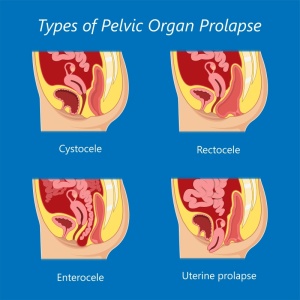
If it feels like something isn’t quite right ‘down there, or you have a feeling of fullness, feel like you’re sitting on a ball, or experience a pressure in your pelvic region, you may have vaginal prolapse.
Vaginal prolapse occurs when a woman’s pelvic floor muscles weaken, causing the uterus, urethra, bladder or rectum to sag and fall down into the vaginal canal. Because the muscles and tissues become weak and stretch, these organs may eventually even protrude out of the vagina.
The Types of Prolapse
- Anterior vaginal prolapse (cystocele or urethrocele) happens when the bladder falls down into the vagina.
- Posterior vaginal prolapse (rectocele) is when the wall separating the rectum from the vagina weakens. This allows the rectum to bulge into the vagina.
- Uterine prolapse is when the uterus droops down into the vagina.
- Apical prolapse (vaginal vault prolapse) is when the cervix or upper part of the vagina falls down into the vagina.
What are the Symptoms?
You may not experience any symptoms of vaginal prolapse. However, if you do, they may include:
- A heaviness sensation or pressure in the pelvic region
- A feeling of fullness in the vagina
- A lump at the opening of the vagina
- A feeling like you’re sitting on a ball
- Pain in your lower back that gets better when you lie down
- The need to urinate more often than normal
- Difficulty having a complete bowel movement or emptying your bladder
- Frequent bladder infections
- Abnormal bleeding from the vagina
- Leaking of urine when you cough, sneeze, laugh, have sex or exercise
- Pain during sex.
What Causes Vaginal Prolapse?
Your pelvic organs are supported by a group of muscles called the pelvic floor muscles. These muscles are often stretched and weakened as a result of childbirth, especially if you had a difficult delivery.
Aging and the loss of estrogen during menopause can further weaken these muscles, allowing the pelvic organs to droop down into the vagina.
Other causes of vaginal prolapse include:
- Pressure from excess weight
- Chronic constipation
- Constant coughing from chronic lung disease
- Lifting heavy objects.
Who is Most at Risk?
You’re more likely to experience vaginal prolapse if you:
- Have gone through menopause
- Had vaginal deliveries, especially a complicated one
- Are chronically constipated and have to strain to have a bowel movement
- Smoke
- Are overweight
- Cough a lot from lung disease
- Had a family member, such as a mother or sister, with prolapse
- Often lift heavy things
- Have fibroids
How is it Diagnosed?
A pelvic exam is performed to diagnose vaginal prolapse. Your doctor might ask you to bear down as if you’re trying to push out a bowel movement.
You may also be asked to tighten and release the muscles that you use to stop and start the flow of urine. This test checks the strength of the muscles that support your vagina, uterus and other pelvic organs.
If you have problems urinating, you may have tests to check your bladder function. This is called urodynamic testing.
- Uroflowmetry measures the amount and strength of your urine stream.
- Cystometrogram determines how full your bladder needs to get before you have to go to the bathroom.
Your doctor might also do one or more of these imaging tests to look for problems with your pelvic organs:
- Pelvic floor MRI – This test uses strong magnets and radio waves to make pictures of your pelvic organs.
- Pelvic ultrasound – This test uses sound waves to check your bladder and other organs.
- CT scan of your abdomen and pelvis – This test uses an X-ray to create detailed pictures of your pelvic organs.
What are the Available Treatments?
Your doctor will recommend the most conservative treatment methods first.
Non-Invasive Treatment Options
Weight loss may help. Losing excess weight can take some of the pressure off your bladder or other pelvic organs. Ask your doctor how much weight you need to lose.
Pelvic floor exercises, also called Kegels, strengthen the muscles that support your vagina, bladder, and other pelvic organs.
Another option is a pessary. This device, which is made from plastic or rubber, goes inside your vagina and holds the bulging tissues in place. It’s easy to learn how to insert a pessary and it helps avoid surgery.
Surgical Repair
If other methods don’t help, you may want to consider surgery to put the pelvic organs back in place and hold them there. A piece of your own tissue, tissue from a donor, or a man-made material will be used to support the weakened pelvic floor muscles. This surgery can be done through the vagina, or through small incisions (laparoscopically) in your abdomen.
Vaginal Prolapse is Treatable
If you have any symptoms of vaginal prolapse, including a feeling of fullness in your lower belly or a bulge in your vagina, see your gynecologist for an exam. This condition isn’t dangerous, but it can have a negative effect on your quality of life.
Vaginal prolapse is treatable. Milder cases can improve with noninvasive treatments like Kegel exercises and weight loss. For more severe cases, surgery may necessary.
Call Us Today
Call us at 770.720.7733 or request an appointment online to discuss your symptoms with one of our double board-certified urogynecologists. Specializing in women’s vaginal health, they will help guide you to the right treatment plan for your unique situation.


